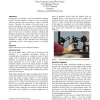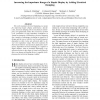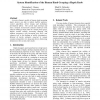52 search results - page 1 / 11 » Designing effective haptic interaction: inverted damping |
CHI
2003
ACM
14 years 5 months ago
2003
ACM
In this paper, we describe a new force-feedback technique termed "inverted damping", which aids users in manually selecting specific items from within a range of possibl...
HAPTICS
2005
IEEE
13 years 10 months ago
2005
IEEE
This work examines electrical damping as a means for improving haptic display performance. Specifically, electrical damping, like its mechanical counterpart, can significantly red...
HAPTICS
2005
IEEE
13 years 10 months ago
2005
IEEE
Rendering stiff virtual objects remains a core challenge in the field of haptics. A study of this problem is presented, which relates the maximum achievable object stiffness to t...
HAPTICS
2010
IEEE
13 years 2 months ago
2010
IEEE
Time delay in haptic telepresence arising from compression or communication alters the phase characteristics of the environment impedance. This paper describes how well a human ope...
HAPTICS
2002
IEEE
13 years 10 months ago
2002
IEEE
Accurate dynamic models of human hands grasping haptic devices can help to inform stability analyses, control algorithms, device design, and technology development efforts. The cu...



